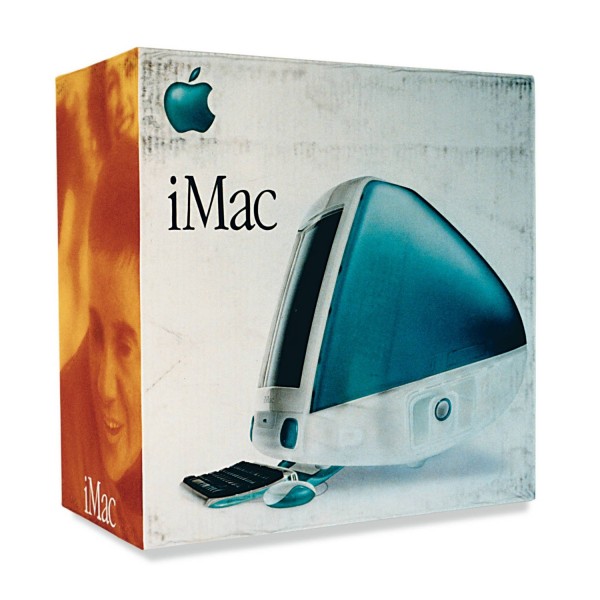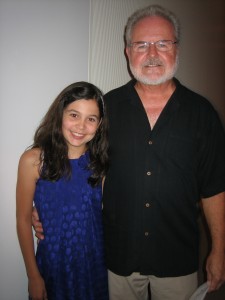Artist Daniel Douke Talks
Boxes, Pop Art and More


Artist Daniel Douke and his granddaughter Sophia (a budding artist) at the Crocker Art Museum, July 14, 2011. Photo: Lesley Stein
Andy Warhol’s paintings of soup cans and Brillo boxes elevated mundane objects to high art in the 1960s. Artist Daniel Douke continues that pop art tradition with his iconic paintings of iMac computer boxes. Only Douke takes the object a step further. Moving beyond the flat one-dimensional painting, Douke creates multi-dimensional works that appear unnervingly real. Creatively stretching canvas over custom-built frames in the shapes of boxes, Douke establishes the base for his realistic works. He then paints every detail found on a real computer box, down to the barcodes, smudges of dirt and the texture of the cardboard. The resulting work is a fascinating mix of photorealism and sculpture.
On July 14th Douke discussed his work during a lively and entertaining one-hour lecture at Sacramento’s Crocker Art Museum. In autobiographical style, Douke presented his audience with a slide show of his life’s work accompanied by humorous background commentary. Refreshingly, Douke’s work is not filled with heavy angst or deep philosophical meaning. His work is straightforward. Pretty much what you see is what you get. Rather, what you think you see is what you get. You may think you are looking at an iMac computer box or slab of steel, when in reality it’s a very realistic rendering of the actual object. Your eye is fooled in a trompe l’oeil way thereby challenging your view.
“I didn’t start out painting boxes,” explained Douke who was born in 1943 in Los Angeles. “I was the kid in junior high who drew on everybody’s notebooks.” While in college Douke viewed Duchamp’s work at the Pasadena Art Museum (now the Norton Simon Museum) at a show put on by the legendary Walter Hobbs that essentially changed his life. At first, Douke came away outraged, thinking this is not art. But within two weeks he started making art just like it. “Bolts of lightening hit my chest from the art of Andy Warhol, Robert Rauschenberg and Roy Lichtenstein,” said Douke. “And Warhol became very influential.”
After earning both a BA and MA from California State University, Los Angeles, Douke made a series of paintings from photos he took of swimming pools. The realistic pieces were all 5’ x 7’ and were painted red, yellow and blue. Said Douke, “Photorealism was a new thing at the time. I of course wanted to be on the cutting edge of newness.” The paintings were a hit when they were shown in 1975 in New York. Douke jokingly speculated, “The reason the show was a success was because it was the dead of winter in New York and here were these warm sunny California scenes.”
But, Douke added, “To me they never looked real. They looked so artificial. Photorealism is only a part of me. I wanted to distance myself when I got back to California.” Influenced by the artist Robert Rauschenberg, Douke found a cardboard box in a dumpster near his studio. And in 1976 he started his series of box paintings that led to a show of the boxes in New York in 1979. These painted boxes included every last detail from address labels, to tape, creases, and dents, just as they appeared on the real object.
Douke moved on to making paintings of steel. At first they were slabs of steel but the work evolved into paintings of curved steel, arched steel, and steel with diamond plate patterns. Next came a series of large-scale cigar boxes followed by paintings of roses found in his wife Nadine’s garden.
Then in 1998 Douke made his first computer box painting. He explained, “Everyone was talking about how wonderful computers were and the packaging started to include pictures.” He said the Apple Mac box with its color monitors reminded him of the flower series paintings he produced earlier.
“I believe it’s important for an artist to respond to the time and place in which you work,” said Douke. To that end the artist began inventing his own computer boxes with fake computer company names. After seeing a Barbie computer box, he created his own version, Studio Display. That painting depicts a computer box on which he added a picture of a Barbie doll on a pink background, stretching Barbie’s neck in a nod to, “Madonna of the long neck.” He said this was his response to Pop Art adding, “I’m in awe of what Mac has done with its packaging. It’s understated elegance.”
During a brief Q&A Douke was asked if he ever goes back to painting what he has previously done. He responded “Yes, but I try to make them not exactly the same.” He concluded by saying, “I got into this because its creative and I want to keep it fresh.”
Douke’s current work is indeed fresh. A recent show at the Peter Mendenhall Gallery in Los Angeles included the artist’s new work. In one of the new pieces, titled Onus, Douke painted a stack of mailboxes he said, “represents the burden America carries including its obsession with youth.” Humorously the name painted on the top mailbox is “Young.” The Mendenhall Gallery aptly describes Douke’s paintings as, “hyper realistic.”
Douke’s talk at the Crocker was just as entertaining as his art. His wonderful sense of humor matches his unique talent as an artist.
Unfortunately, the Crocker’s exhibit of Douke’s work “Daniel Douke: Bytes of Reality,” closed on July 17th. Perhaps in the future, the museum will schedule artist’s lectures earlier in the course of their corresponding exhibits, instead of three days before the show closes.



I thoroughly enjoyed Lesley Stein’s photos. They had substance and were beautiful. I’ve known Lesley since she was a very young woman. She excels in whatever she does. She accomplishes her goals with tenacity and perfection. She is truly and artist.